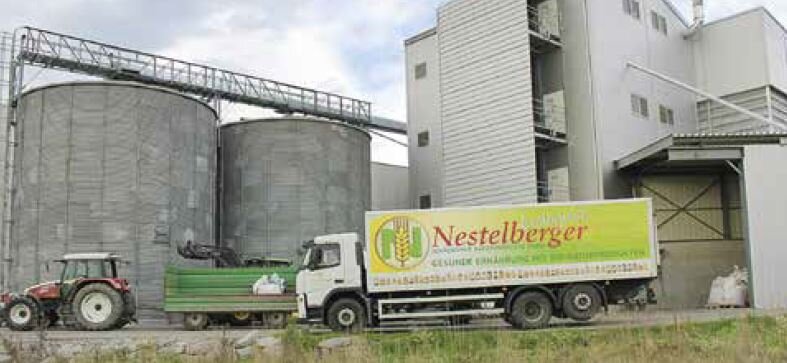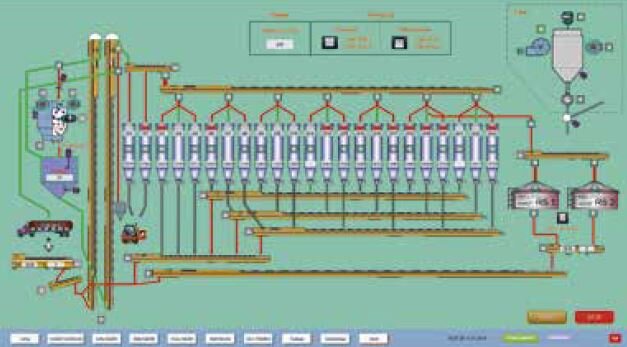Unser umfangreiches Robotersortiment bietet neben anwendungsbezogenen Varianten wie Schweiss-, Palettier-, Lackier- und Handling-Roboter auch Modelle für Labor- und Reinraumapplikationen sowie schlüsselfertige automatisierte Schweißsysteme höchster Qualität.
Yaskawa Components ensure fully automatic operation
- Branchen
- Lebensmittel/Nahrungsmittel
- Agrar
- Kunde
- Nestelberger
Full silos
Until grain has been milled to flour and finally lands on the consumer’s table as bread or cake, the cereal grain must go through several production stages from the field to the bakery. This chain of procedures can be illustrated by a visit to the Nestelberger hulling mill and silo at Perg, Upper Austria, which now uses an automation solution incorporating Vipa and Yaskawa components.
After the harvest, the silos at the Nestelberger hulling mill are full of organic grain. “We have about 2,500 tonnes of spelt, wheat, barley, oats, etc. in 24 storage cells,” explains Peter Pilsl, responsible for production at the Nestelberger hulling mill.
However, before this stage is reached, the cereal grain must undergo several processing steps: the grain is conveyed to the mill, where it is cleaned (relieved of stones, weeds and similar, i.e. everything that was picked up during harvesting) and weighed. During cleaning and weighing the grain falls back down, where it is hulled and/or conveyed up to the silos for storage.
In-depth knowledge of the overall process is indispensable for optimum automation of a system of this size. Andreas Stingeder from electrical contractor MESTA was responsible for the overall planning, switch cabinet design, cabling, programming, visualization and commissioning. During construction and commissioning, Stingeder was also involved in the management of the hulling mill and is now ’fully in the picture’,” as he says.
The mill operator can adjust all parameters with the visualization of Zenon software from Copa Data. In the first step the grain type is selected. Then the desired process – hulling, storage or filling – can be easily selected by means of a graphic with only a few clicks. Once the desired path for the grain has been set, the system operator initiates the process with the “Start” button – and the mill is put into operation.
The process is highly convenient for the mill operator, who can now run the mill alone in fully automatic mode.
Implementation
The reason that a complex system like this can be operated in such a simple manner is to be found primarily in the automation components employed. “It was the first project implemented together with Austrian VIPA Elektronik-Systeme GmbH. For me the solutions from Vipa and Yaskawa were conclusive and proved to be best suited to our projects right from the outset. At no point in time did we have any problems with these components,” emphasizes Andreas Stingeder.
“Having said that, in the course of time the range of components requested from us became more and more comprehensive. Initially we were only talking about a controller. After several consultations we recognized that we had more interfaces at which we were able to cooperate,” adds Christian Karl, Product Manager Drives & Motion at Vipa Elektronik- Systeme GmbH.
The reason is that at the beginning of the project the customer was not entirely clear about the degree of automation needed. “The full extent of automation only became apparent over time. Now we are employing virtually the full range of products of Vipa Elektronik-Systeme, from Vipa and Yaskawa components to Zenon. The advantage is that everything is drawn from one source. Above all, the customer was convinced by the level of service at VIPA Elektronik-Systeme with competent contact partners and fast delivery times,” says Stingeder.
In detail
Essentially, the Nestelberger hulling mill consists of two parts. On the one side is the silo for storing the grain and on the other side the hulling machine. Both of these are controlled by a SLIO CPU 015 with memory expansion. The controller is thus responsible for all motors of the conveyor systems – vertical and horizontal – as well as screw conveyors, dosing valves, fill-level monitoring and the contact detectors of slide valves. In addition, the controller is equipped with a coupling via Ethernet for the visualization via zenon.
“Communications are generally via Profibus, although the YASKAWA frequency inverters are compatible with all standard bus systems,” says Karl. A total of three YASKAWA V1000 frequency inverters are being used to control the drives. The frequency inverters of this series are impressive not only due to their small size, but also on account of their extremely robust electronics and high performance levels. “These frequency inverters are really extremely robust. Power cuts or load shedding following an emergency stop – no problem at all. I’ve experienced plenty of frequency inverters in my time which would not have withstood such punishment,” Stingeder reports.
“The ruggedness of these frequency inverters can be attributed to the extremely well dimensioned power elements with considerable reserves – they have to endure a lot,” Karl adds.
For problems occurring in operation of the system, Stingeder has incorporated textbased error messages in the visualization by zenon. Now it can be seen at a glance where which error has occurred and the system operator immediately knows the score.
Overall Package
“Yaskawa and Vipa products were the ideal solution for this project. In future I will gladly turn to these products – at the moment I can hardly imagine anything else. But the outstanding components themselves are only half the story. If I have any questions I just call Vipa Elektronik Systeme, where I receive immediate answers and suggestions for solutions – from competent contact partners,” Stingeder sums up.
The technical conclusion at the hulling mill is a remote maintenance solution which will in all probability be implemented with eWON. This will enable the management of the Nestelberger hulling mill to retrieve all production data and system status via the Internet or mobile devices.





















